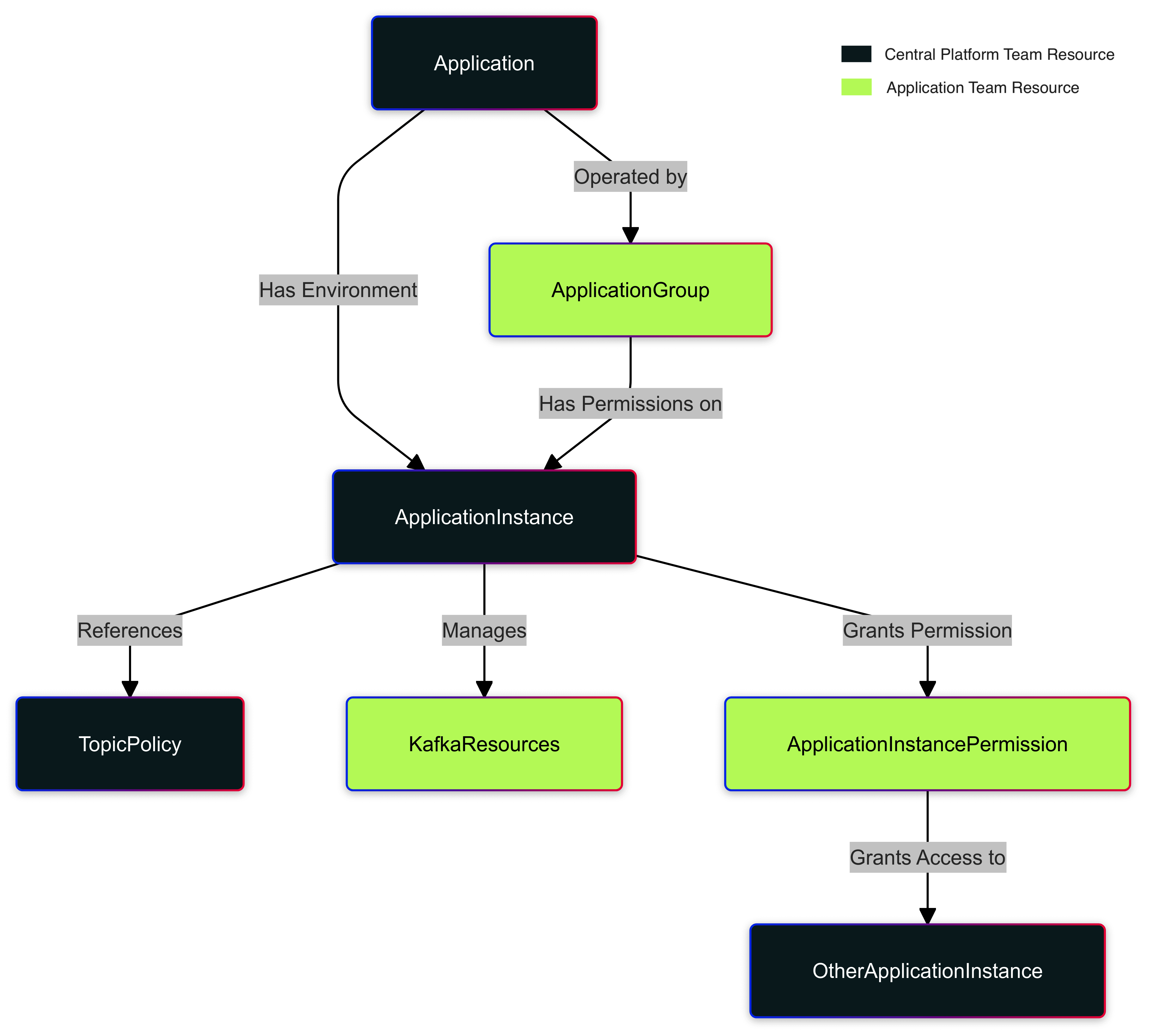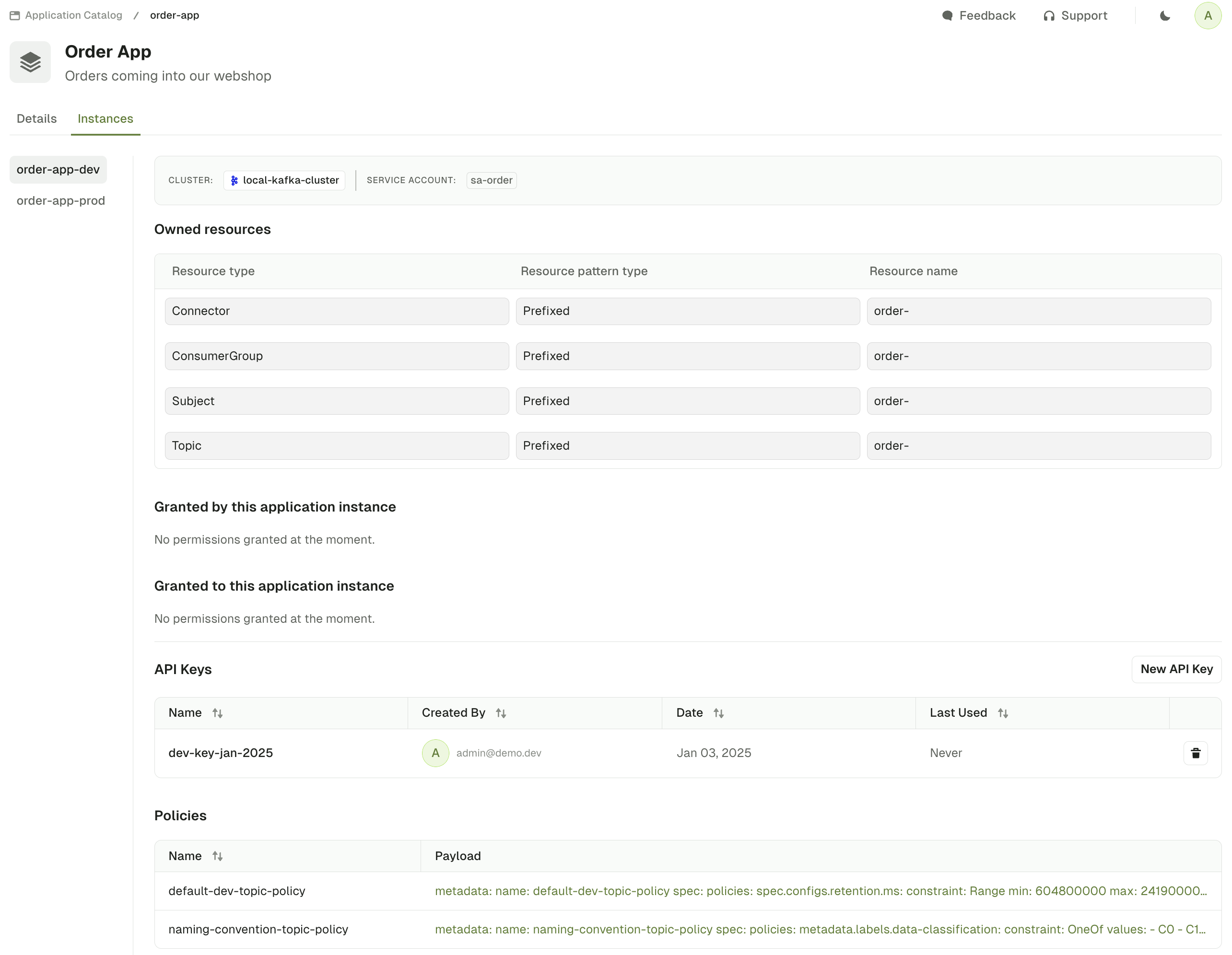Kafka Self-service
Overview
Self-service helps you scale Kafka usage in your organization by facilitating collaboration between the Central Platform team and Application teams.
It simplifies and automates processes, establishes clear rules and ways of working, and standardizes the creation and management of Kafka resources.
This approach brings governance into your enterprise through concepts like Ownership and Applications, delegating operations to the Application Teams rather than the Central Platform Team.
- For a presentation of Self-service and its key concepts, see Get started with Self-service
- For the full definition of each resource, see Self-service resource reference
Benefits for Central Platform team
- Define the general rules of the game
- Enforce naming conventions
- Safeguard from invalid or expensive configurations (wrong replication factor, high partition number, ...)
- Declare the Applications and their rights
Benefits for Applications teams
- Autonomy and responsibility over their resources
- Isolation with Application namespaces
- Collaboration through permission delegation without any help from the Central Platform team
- Discoverability through Topic Catalog
Concepts
Self-service relies on a central concept, the Application, which dictates ownership of Kafka resources.
Below outlines the relationships between Self-service resources.

Central Platform team resources
Application
An application represents a streaming app or data pipeline that is responsible for producing, consuming or processing data from Kafka. Applications give business context to Kafka resources (topics, consumer groups & subjects) that directly relate to the functioning of that application or pipeline.
Example
---
apiVersion: "self-service/v1"
kind: "Application"
metadata:
name: "clickstream-app"
spec:
title: "Clickstream App"
description: "Clickstream records user’s clicks through their journey on our website"
owner: "clickstream-group" # technical-id of the Console Group
Application instance
Applications are generally deployed to one or more Kafka clusters, typically to align with the organization's development cycle or environments. We call this concept the Application instance.
Each Application Instance:
- Is linked to a Kafka Cluster and a Service Account
- Has ownership on the Kafka resources (topics, consumer groups, subjects, ...)
- Grants the permissions
- On the Service Account using Kafka ACLs (
Read & Writeon Topics,Readon ConsumerGroups) - On the Application owner group in Conduktor Console using RBAC (
Adminpermissions)
- On the Service Account using Kafka ACLs (
Example
# Application Instance (dev environment)
---
apiVersion: "self-service/v1"
kind: "ApplicationInstance"
metadata:
application: "clickstream-app"
name: "clickstream-app-dev"
spec:
cluster: "shadow-it"
serviceAccount: "sa-clickstream-dev"
resources:
- type: TOPIC
name: "click."
patternType: PREFIXED
- type: CONSUMER_GROUP
name: "click."
patternType: PREFIXED
Application instance policies
Application Instance Policies restrict the Application Teams to create their resources following certain rules.
These rules can be related to Kafka configs but can also apply to metadata.
This is what lets Platform Administrators provide a Self-service experience that doesn't look like the Wild West.
Example
# Policies that restrict the Application to a certain range of configurations
# on topic configs, but also on topic metadata
---
apiVersion: "self-service/v1"
kind: "TopicPolicy"
metadata:
name: "generic-dev-topic"
spec:
policies:
metadata.labels.data-criticality:
constraint: OneOf
values: ["C0", "C1", "C2"]
spec.configs.retention.ms:
constraint: "Range"
max: 42
min: 3
Application team resources
Once an Application & Application Instance are defined, Application Teams can now organize and structure their application as they see fit. There are two groups of resources where Application Teams are given autonomy:
- Kafka-related resources,
Topic,Subject,Connector,ApplicationInstancePermission. - Console-related resources, in particular
ApplicationGroup, allowing them to define internally who can do what within their Team.
Kafka resources
This is how Application Teams can create the Kafka resources they need for their applications.
# Topic example
---
apiVersion: kafka/v2
kind: "Topic"
metadata:
cluster: "shadow-it"
name: "click.screen-events"
spec:
replicationFactor: 3
partitions: 6
configs:
min.insync.replicas: "2"
cleanup.policy: "delete"
retention.ms: "60000"
Application instance permissions
Application Instance Permissions lets teams to collaborate with each others.
Deploying this object will grant permission to the grantedTo Application Instance:
- To its Service Account (Kafka ACL)
- To the Application Team members in Conduktor Console
Example
# Read permission granted to the Heatmap Application on click.screen-events topic
---
apiVersion: self-service/v1
kind: "ApplicationInstancePermission"
metadata:
application: "clickstream-app"
appInstance: "clickstream-app-dev"
name: "clickstream-app-dev-to-heatmap"
spec:
resource:
type: TOPIC
name: "click.screen-events"
patternType: LITERAL
permission: READ
grantedTo: heatmap-app-dev
Application group
Create an Application Group to directly reflect how your Application operates. You can create as many Application Groups as required to restrict or represent the different teams that use Console on your Application, e.g.:
- Support Team with only Read Access in Production
- DevOps Team with extended access across all environments
- Developers with higher permissions in Dev
Example
# Permissions granted to Console users in the group, CP-COMPANY-CLICKSTREAM-SUPPORT, for the clickstream-app Application
---
apiVersion: self-service/v1
kind: "ApplicationGroup"
metadata:
application: "clickstream-app"
name: "clickstream-support"
spec:
displayName: Support Clickstream
description: |
Members of the Support Group are allowed:
Read access on all the resources
Can restart owned connectors
Can reset offsets
permissions:
- appInstance: clickstream-app-dev
resourceType: TOPIC
resourcePatternType: "LITERAL"
resourcePattern: "*" # All owned & subscribed topics
permissions: ["topicViewConfig", "topicConsume"]
- appInstance: clickstream-app-dev
resourceType: CONSUMER_GROUP
resourcePatternType: "LITERAL"
resourcePattern: "*" # All owned consumer groups
permissions: ["consumerGroupCreate", "consumerGroupReset", "consumerGroupDelete", "consumerGroupView"]
- appInstance: clickstream-app-dev
resourceType: CONNECTOR
resourcePatternType: "LITERAL"
resourcePattern: "*" # All owned connectors
permissions: ["kafkaConnectorViewConfig", "kafkaConnectorStatus", "kafkaConnectPauseResume", "kafkaConnectRestart"]
members:
- user1@company.org
- user2@company.org
externalGroups:
- GP-COMPANY-CLICKSTREAM-SUPPORT
Resource labels
Labels are key value pairs with no constraints to help you organize and surface business metadata into Console. It is our objective that all resources that can be created using the Conduktor CLI can be annotated with metadata in the form of labels.
Today we have label support for a subset of our resources:
- KafkaCluster
- KafkaConnectCluster
- Topic
- Subject
- Connector
We plan to bring label support to the following resources in the future:
- KsqlDBCluster
- User
- Group
- TopicPolicy
- Application
- ApplicationInstance
- ApplicationInstancePermission
- ApplicationGroup
Example
# Topic annotated with useful metadata
---
apiVersion: kafka/v2
kind: "Topic"
metadata:
cluster: "shadow-it"
name: clickstream.events
labels:
description: "A description for what kind of data this topic contains."
business-data-classification: C2
business-doc-url: "https://confluence.company.org/display/CLICK/Kafka"
application-code: CLK
environment-code: dev
spec:
replicationFactor: 3
partitions: 6
configs:
min.insync.replicas: "2"
cleanup.policy: "delete"
retention.ms: "60000"
Limited ownership mode
To help organizations transition to Self-service more easily, we have added a new attribute on ApplicationInstance to let Platform Teams decide the level of autonomy to give to Application Teams.
- ApplicationInstance resources configured with
ownershipMode: ALL, which is the default, delegates all permissions related to that resource to the Application Team. - ApplicationInstance resources configured with
ownershipMode: LIMITEDdelegates only a subset of the available permissions to the Application Team.
This is especially useful if Central Team have a centralized repository and existing workflow for Topic (or other resource) creation and wants to still own that part of the process.
This way they can provide Self-service capabilities while still having Application Teams to go through their pipeline for Topic Creation, instead of Self-service.
| Restricted Permissions in LIMITED | Description |
|---|---|
| Topic | |
topicEditConfig | Permission to edit the topic configuration. |
topicCreate | Permission to create a new topic. |
topicDelete | Permission to delete the topic. |
topicAddPartition | Permission to add partitions to the topic. |
| Subject | |
subjectCreateUpdate | Permission to create or update the subject. |
subjectDelete | Permission to delete the subject. |
subjectEditCompatibility | Permission to edit the subject compatibility settings. |
| Consumer Group | |
consumerGroupCreate | Permission to create a new consumer group. |
consumerGroupDelete | Permission to delete the consumer group. |
| Kafka Connect | |
kafkaConnectorEditConfig | Permission to edit the Kafka Connect configuration. |
kafkaConnectorDelete | Permission to delete connectors. |
kafkaConnectorCreate | Permission to create new connectors. |
Self-service UI
Self-service currently relies principally on the Conduktor CLI.
The Console UI reconciles actions executed via the CLI to present Read Only views of your Application Catalog and Topic Catalog. This promotes discoverability of Kafka resources with business context inside your organization.
